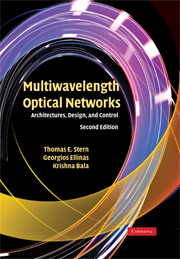Book contents
- Frontmatter
- Contents
- Figures
- Tables
- Preface to the Second Edition
- Acknowledgments
- Multiwavelength Optical Networks
- 1 The Big Picture
- 2 The Layered Architecture and Its Resources
- 3 Network Connections
- 4 Enabling Technology
- 5 Static Multipoint Networks
- 6 Wavelength/Waveband-Routed Networks
- 7 Logically-Routed Networks
- 8 Survivability: Protection and Restoration
- 9 Optical Control Plane
- 10 Optical Packet-Switched Networks
- 11 Current Trends in Multiwavelength Optical Networking
- A Graph Theory
- B Fixed Scheduling Algorithm
- C Markov Chains and Queues
- D A Limiting-Cut Heuristic
- E An Algorithm for Minimum-Interference Routing in Linear Lightwave Networks
- F Synopsis of the SONET Standard
- G A Looping Algorithm
- Acronyms
- Index
7 - Logically-Routed Networks
Published online by Cambridge University Press: 05 June 2012
- Frontmatter
- Contents
- Figures
- Tables
- Preface to the Second Edition
- Acknowledgments
- Multiwavelength Optical Networks
- 1 The Big Picture
- 2 The Layered Architecture and Its Resources
- 3 Network Connections
- 4 Enabling Technology
- 5 Static Multipoint Networks
- 6 Wavelength/Waveband-Routed Networks
- 7 Logically-Routed Networks
- 8 Survivability: Protection and Restoration
- 9 Optical Control Plane
- 10 Optical Packet-Switched Networks
- 11 Current Trends in Multiwavelength Optical Networking
- A Graph Theory
- B Fixed Scheduling Algorithm
- C Markov Chains and Queues
- D A Limiting-Cut Heuristic
- E An Algorithm for Minimum-Interference Routing in Linear Lightwave Networks
- F Synopsis of the SONET Standard
- G A Looping Algorithm
- Acronyms
- Index
Summary
In this chapter we explore the structure, design, and performance of purely optical networks with electronically switched overlays. These are the logically-routed networks (LRNs) that were introduced in Section 3.5. Typical examples of LRNs are networks of SONET digital cross-connects (DCSs), networks of IP/MPLS routers, and ATM networks carried on a SONET DCS layer. To provide maximum flexibility, the LRN should be carried on top of a reconfigurable optical network. Although we generally refer to the underlying infrastructure as “purely optical” (that is, transparent), we shall, from time to time, relax that requirement to include optical networks having some degree of opacity on their transmission links.
Introduction: Why Logically-Routed Networks?
The rationale for using logical switching on top of a purely optical infrastructure has been discussed at various points throughout the book. The number of stations in a purely optical network cannot be increased indefinitely without running into a connectivity bottleneck. The sources of the bottleneck are the resource limitations within the network (fibers and optical spectrum) and within the access stations (optical transceivers).
Figure 7.1(a) illustrates the bottleneck in a purely optical network. Network access station (NAS) A has established logical connections (LCs), shown as dashed lines in the figure, that fan out to stations B, C, and D. If this is a wavelength-routed network (WRN), each LC is carried on a separate point-to-point optical connection; that is, three optical transceivers and three distinct wavelengths are required (assuming that the stations have single fiber pair access links).
- Type
- Chapter
- Information
- Multiwavelength Optical NetworksArchitectures, Design, and Control, pp. 576 - 646Publisher: Cambridge University PressPrint publication year: 2008

